| کد مقاله | کد نشریه | سال انتشار | مقاله انگلیسی | نسخه تمام متن |
|---|---|---|---|---|
| 872899 | 910287 | 2009 | 13 صفحه PDF | دانلود رایگان |

Mandibular condylar cartilage plays a crucial role in temporomandibular joint (TMJ) function, which includes facilitating articulation with the TMJ disc, reducing loads on the underlying bone, and contributing to bone remodeling. To improve our understanding of the TMJ function in normal and pathological situations, accurate and validated three-dimensional (3-D) finite element models (FEMs) of the human TMJ may serve as valuable diagnostic tools as well as predictors of thresholds for tissue damage resulting from parafunctional activities and trauma. In this context, development of reliable biomechanical standards for condylar cartilage is crucial. Moreover, biomechanical characteristics of the native tissue are important design parameters for creating functional tissue-engineered replacements. Towards these goals, biomechanical characteristics of the condylar cartilage have been reviewed here, highlighting the structure–function correlations. Structurally, condylar cartilage, like the TMJ disc, exhibits zonal and topographical heterogeneity. Early structural investigations of the condylar cartilage have suggested that the tissue possesses a somewhat transversely isotropic orientation of collagen fibers in the fibrous zone. However, recent tensile and shear evaluations have reported a higher stiffness of the tissue in the anteroposterior direction than in the mediolateral direction, corresponding to an anisotropic fiber orientation comparable to the TMJ disc. In a few investigations, condylar cartilage under compression was found to be stiffer anteriorly than posteriorly. As with the TMJ disc, further compressive characterization is warranted. To draw inferences for human tissue using animal models, establishing stiffness–thickness correlations and regional evaluation of proteoglycan/glycosaminoglycan content may be essential. Efforts directed from the biomechanics community for the characterization of TMJ tissues will facilitate the development of reliable and accurate 3-D FEMs of the human TMJ.
Journal: Journal of Biomechanics - Volume 42, Issue 4, 11 March 2009, Pages 405–417